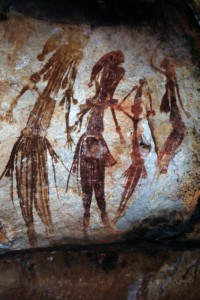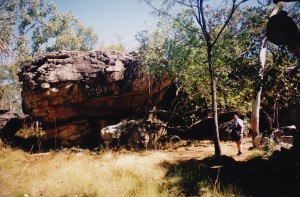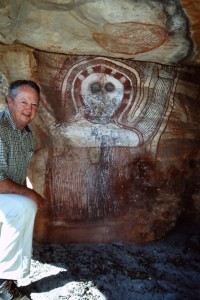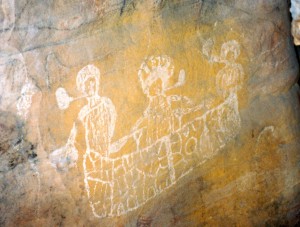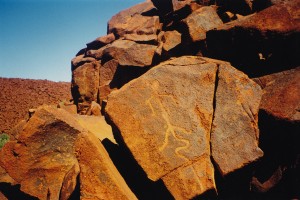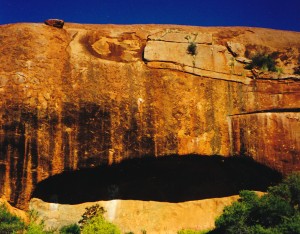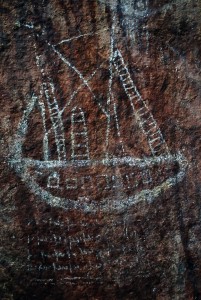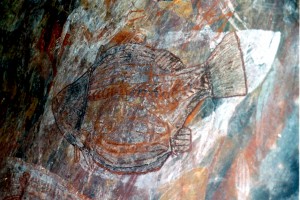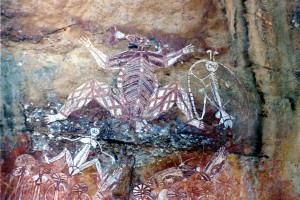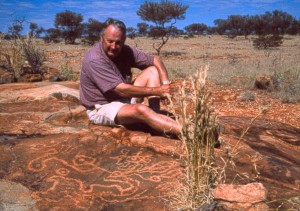OUR ANCIENT ART GALLERIES
Caravan+RV June/July Issue
Australia has rich galleries of ancient cave paintings and rock art. Tim Bowden and his wife Ros have seen plenty with their trusty Landcruiser Penelope and their off-road camper.
I remember, vividly, the moment I was hooked on rock art. It was in 1999 on the Gibb River Road, where the four-wheel-drive track to the Mitchell Plateau turns off from the road to Kalumburu and crosses the King Edward River. A knowledgeable friend had told me where to look. ‘Just wander around the rocky outcrops and look for likely overhangs, or places where galleries might be.’
We had no luck for a while, and then I stumbled upon this magnificent painting – four graceful figures outlined in brown ochre, so old that the paint had become fused into the rock face. They appeared to be dancers, lithe and graceful, looking rather Asian I thought, with amulets and ornamental tassels hanging from their arms. On their heads were curiously elongated top-knots, perhaps ceremonial headdresses. Around their waists were what could have been grass skirts and more dangling amulets. These exquisite paintings were displayed, like icons in a church, in a naturally framed ‘window’ on the rock face.
Not far away in some other rock galleries, we had seen some Wandjina paintings – some looking as though they had been recently touched up with fresh paint – with their distinctive white halos, round faces with eyes and noses carefully outlined – but no mouths. The figures we were looking at were utterly different, as though created by a distinctly different culture. We had stumbled on our first Bradshaws, which are only found in the Kimberley, and named after the explorer Joseph Bradshaw who saw and described similar paintings near the Prince Regent River in 1891.
Debate is still going on – and may never be resolved – on how old they are. Estimates range from 30 000 years to 50 000 years. Perhaps they were created by an immigrant people who landed in the Kimberley, and who either died out, or moved on. Aboriginal people have no Dreamtime myths or legends about the Bradshaws, and tend to regard them as unimportant to their culture, often painting their Wandjinas over the top of these slender, intriguing figures, which were painted earlier in some of the best locations under overhangs and in caves.
Most guide books describe where Wandjina and Bradshaw paintings can be found in the Kimberley near the Gibb River Road. Some are on station properties like Mount Elizabeth further south.
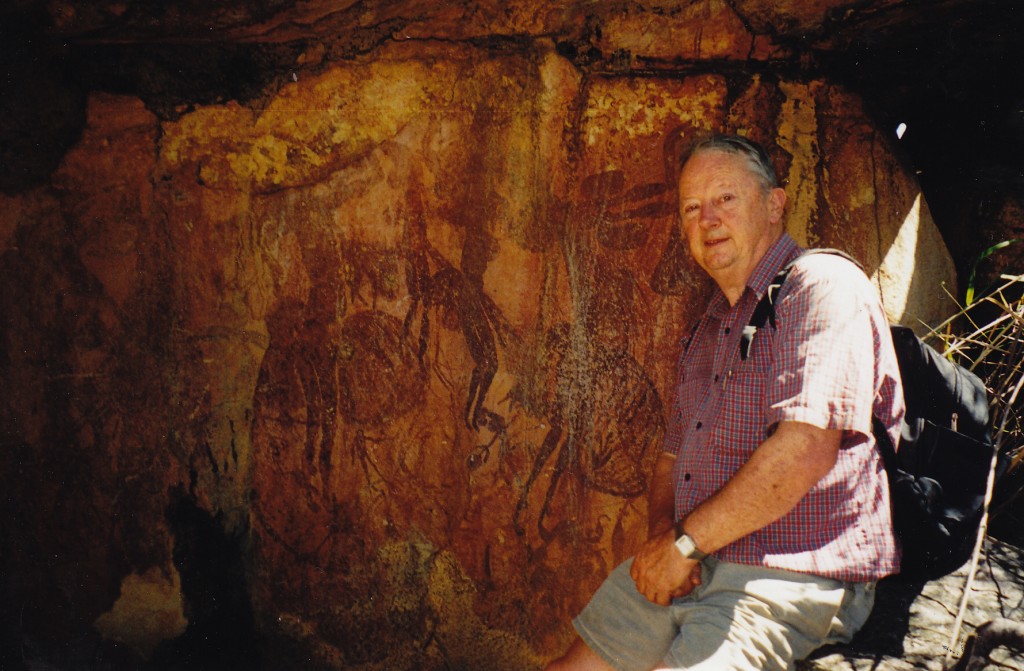
Tim poses with some of the mysterious Bradshaw paintings. Were they drawn by a race that predated the Aborigines?
It is simply amazing how much of this ancient art is available to the discerning traveller if you take a bit of local advice – the unprotected sites are never signposted, to try and protect them from vandalism.
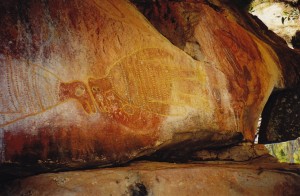
Here some mythical spirit figures have been painted over the earlier Bradshaw figures by later Aboriginal artists.
More Bradshaws and Wandjinas can be seen from the popular El Questro resort and camping ground on the Chamberlain River, not far from Kununurra. You take a tour to see those.
Anthropologists and archaeologists believe that the first humans entered Australia from the Kimberley region, having come by a combination of land bridges and boats from South-east Asia no less than 40 000 years ago. The Kimberley coast is so rugged – its ancient tilted rock formations gashed by great fissures and inlets through which twelve metre tides ebb and flow – that it is best seen by boat.
Ros and I voyaged on the Coral Princess, back in 1999, an Aurora Expeditions charter from Broome to Admiralty Gulf and back to Broome. Apart from the scenic delights, bird watching, croc-spotting and swimming (in fresh water creeks out of reach of croc) there were great opportunities to indulge my new passion –visiting rock art gallery sites impossible to reach by road.
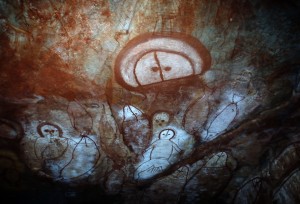
A fine example of Wandjina art seen in a cave above Raft Point in the Kimberley.Note the haloed heads.
Climbing to a cave above Raft Point, we saw an improbable mix of Wandjina spirit figures – their white haloed heads were deemed to be evidence of space-helmeted aliens, according to the deluded Swiss-born author Erich von Daniken – surrounded by big dugong-style figures with Wandjina style heads, with occasional glimpses of spidery, graceful Bradshaw figures peeping out coyly from the three-times-human size of the Wandjinas that had been painted over them.
On Bigge Island at Wary Bay we entered one of the most remarkable natural galleries I have ever seen. The fissures in the cliff were vertical, so the paintings were not created under the usual overhanging rock shelf. Inside, standing with plenty of headroom, we could see the mysterious and controversial ‘pipe smoking Dutchmen’ paintings, where European looking figures in pantaloons can be seen in dinghy-style boats. On one wall was painted a thylacine with its distinctively striped back.
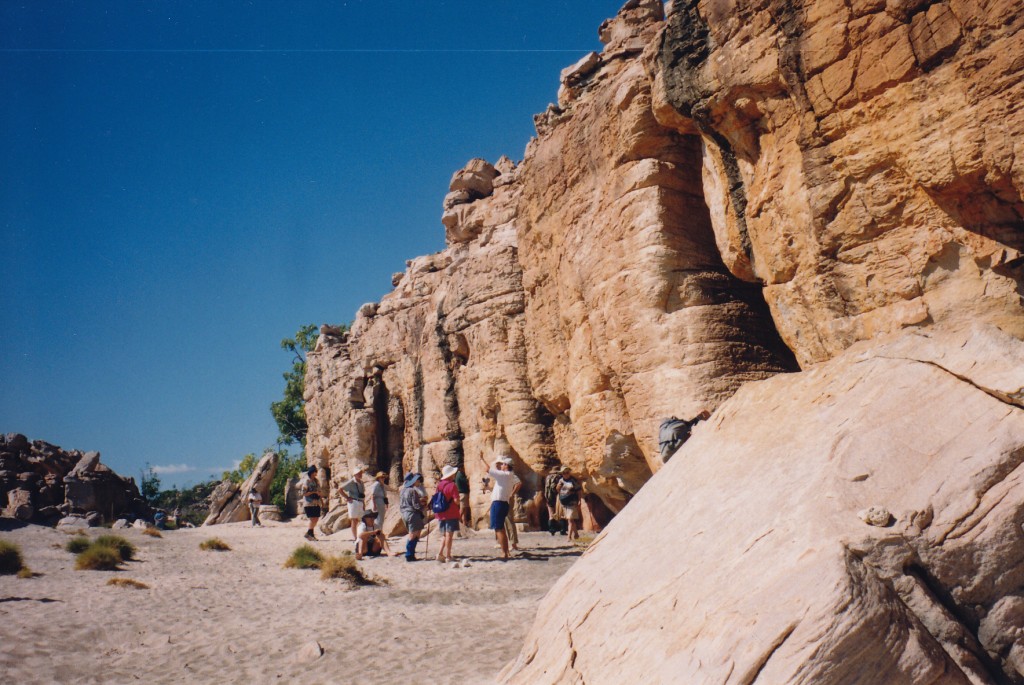
Vertical slits in the sandstone rock at Wary Bay, Bigge Island, lead to the rich Kimberley art galleries within.
The same friend who alerted me to the location of the Bradshaws off the Gibb River Road in the Kimberley said he would personally roast my gonads slowly over my own camp fire if I did not seek out the magnificent rock carvings on the Burrup Peninsula, near Karratha, some 200 kilometres south from Port Hedland.
Like the Bradshaws, rock carvings (petroglyphs) are so old that Australian Aborigines have no explanation or interpretation of them in their Dreaming. Any rock engraving is immensely old – dating back 30,000 years or more in some locations. Archaeologists keep pushing back the dates of human presence in Australia.
We were alerted to some rock carvings near Marble Bar in the Pilbara and quickly found them on our way to the Burrup Peninsula.
There are an estimated 8000 carvings in the Burrup Peninsula, many within sight of the processing plant for the huge offshore North West Shelf Gas Project, its tall tower topped by a torch of flame burning off excess gas. The carvings are not hidden away, but visible in full sun on smooth bronze-coloured rock boulders, their shiny surfaces darkened by iron oxide over the millennia.
You are likely to find these engravings anywhere on the peninsula, but tourists are directed to Hearson Cove, near the end of the road to the port of Dampier. Here there are so many carvings that almost every boulder seems inscribed with a staggering variety of images. As well as concentric circles and other symbolic shapes, there are human figures, fish, whales, dolphins and turtles. Among the birds are waders, in silhouette with long necks and curved beaks, some with fish in their beaks. Land animals include kangaroos, lizards, lizards, snakes and thylacines.
If this was not exciting enough, we had taken local advice – always essential in seeking out rock art – to find the rock panel featuring the famous ‘climbing men’. This happened to be surprisingly close to the big, flaming gas-escape tower. Figures are depicted climbing on each side of a vertical line. There is nothing else like them on the peninsula. Archaeologist Josephine Flood has speculated that they might represent young men climbing a tree in an initiation ceremony. A nearby panel showed heraldic looking designs that looked more like decorations on an Etruscan tomb than Aboriginal petroglyphs. The range of etched images on the Burrup Peninsula is truly astonishing. And can be seen for free!
Unfortunately the industrial development on the peninsula has disrupted significant areas of these ancient art galleries. In the course of building the gas plant, Woodside Offshore Petroleum Ltd moved some 1793 engraved boulders from their original sites, and put them in a fenced enclosure away from public access. Since we were there further gas developments are planned on the Burrup Peninsula which could have disastrous effects on what should be a world heritage site.
While the Burrup Peninsula has this extraordinary concentration of stone engravings, there are other petroglyphs to be seen elsewhere in the Pilbara. We found and photographed some beauties near Marble Bar by reading local tourist information. Tours are also available.
One of the most intriguing rock art sites we visited was in the Mid West of Western Australia, about 80 kilometres south-west from the old gold mining town of Cue. Walga Rock looks a bit like a mini-Uluru, but does not similarly dominate the countryside. It does have a fabulous 60-metre-long rock art gallery underneath a protective fold of granite. Among the Aboriginal paintings – not engravings – is a ship, depicted in white ochre, with masts, rigging and ratlines, seven square portholes and four wavy white lines underneath its hull which at first glance looks like some kind of script, but could represent water.
Why there should be a painting of a European ship 325 kilometres inland from the Indian Ocean remains a mystery. Theories range from a hoax, to evidence of shipwrecked Dutch sailors in the seventeenth century being taken in by Aboriginal tribes. Josephine Flood confirms that the paint used is the same elsewhere in the gallery, and thinks the painting may be an Aboriginal artist recording his first impression of a ship and the ocean. There is good camping around Walga Rock, and no entrance fee. Where else but in Australia could visitors see such wonders?
There is an explosion of artistic creativity in many of Australia’s remote Aboriginal communities. On our way to Broome up the Tanami Road, we called in to Balgo, just across the Northern Territory border into Western Australia, south of Halls Creek. (We had previously contacted the Warlayirti Artists’ Cooperative to ask permission to visit – an important pre-requisite when visiting any of northern and central Australian Aboriginal communities.)
As we pulled into the settlement, we asked directions from a slightly built, bearded Aboriginal, almost lost in the folds of a huge overcoat. We found out later that this cheerful old man was none other than the famous artist Helicopter, one of the most sought after artists at Balgo. (As a young boy he was brought in from the desert by a helicopter, and the name just stuck!)
At the Cooperative we saw the community’s artists at work, and could not resist buying a striking and colourful abstract desert painting by Elizabeth Nyumi – who is now one of central Australia’s most sought after painters. I also fell for a traditional dot painting of a frill-necked lizard by one of the younger artists, Gemma Galova. We saw Helicopter happily sitting cross-legged on the veranda, with his dogs for company, working on a huge dot painting. But he was out of our price range.
While it is not forbidden to climb Uluru (Ayers Rock), the local Warlpiri people would rather you didn’t. It is much better value, in my view, to walk around the base of the rock to not only admire its naturally sculptured magnificence, but to visit some of the rock art galleries there that are open to the public – some are not. Contemporary Aboriginal desert paintings can be purchased on location, or at art shops in Alice Springs.
Providing you ask in advance it is possible to visit art centres in remote communities like Papunya, Utopia, Yuendumu and Ernabella. Ernabella was established as a Presbyterian mission in 1937. Ros and I first went there in 1974 when the late Winifred Hilliard was encouraging the Ernabella women to experiment with new art forms. When she arrived at the settlement in the 1950s, the women were already weaving traditional designs into woollen rugs. Winifred encouraged the young people to experiment, first with crayons, pastel and art paper. When the distinctive and now famous ‘Ernabella designs’ began to emerge, she helped facilitate the manufacture of batik cloth using Indonesian techniques. ‘Purists’ criticised this at the time, but it was just one manifestation of the surge of Aboriginal creativity that is now extending the boundaries of traditional desert art. Today, Ernabella’s print screen fabrics, etchings and lithographs are featured in leading galleries in Australia and overseas.
With the dry season comes the chance to explore the Top End, also rich with rock galleries. The jewel in the crown, of course, is Obiri Rock (now known as Obirr) high on a sandstone escarpment, west of the East Alligator River and on the northern end of Kakadu National Park.
Its great overhangs shelter a cornucopia of well-preserved paintings, with the added joy of panoramic views over the surrounding plains and wetlands. Not far away is Nourlangie Rock, with its own very fine galleries. When we were last there in 2005 we found many of the paintings were only visible from behind guard rails. An ranger told us that a stupid overseas visitor, who did not believe that the oche paintings were hundred of years old, had tried to rub them off the rock wall with a wet towel! The traditional owners were so furious they wanted to close Nourlangie Rock completely but relented providing the protective barriers were built.
The different styles of Aboriginal painting never ceases to amaze and enchant. In the Mid West of Western Australia, some 300 kilometres east from Carnarvon is the massive bulk of Mt Augustus. We were alerted to some rock art that seemed as though it might have been inspired by John Olsen’s meandering lines – or perhaps the other way round.
Further south at Erong Springs we were taken out by the owners to an ancient Aboriginal site, near permanent water. Sue Graham showed us petroglyphs, rather similar in style to the painted art we had seen at Mt Augustus – some concentric circles, spear heads and one recurring motif were small circles with lines trailing away from one side, almost like a squid (although that was unlikely so far from the sea).
Sue had also found circular depressions in the rock she was sure had been used by women for grinding seeds for food. She had seen fragments of broken rounded stones which could have been grinding stones. Sue wondered whether there may have been a custom of breaking an individual’s personal grinding stone after they died. The previous station owners had shown her one remarkable site, and we saw it too, where someone’s precious spherical grinding stone was sitting in a shallow rock depression. For how many hundreds or even thousands of years had that woman’s grinding stone been left there undisturbed in isolation. We were permitted to photograph it, as 0nly Sue and her husband Chris Graham know of its location.
How privileged we are as campers and travellers not only to be able to see such a rich variety of Aboriginal rock art sites, but to often have them absolutely to ourselves to appreciate. This is not the case in Europe, where visitors stand in queues to see replica Palaeolithic cave paintings at Lascaux!
You could do worse than design an entire camping trip around experiencing our rich treasure trove of ancient Aboriginal art.
IF YOU HAVE A COMMENT ON THIS ARTICLE OR ANY OTHER POSTING ON THIS WEBSITE PLEASE USE THE CONTACT BUTTON UNDER THE MAIN BANNER.

